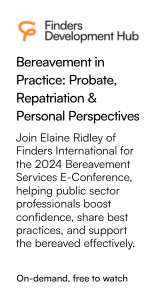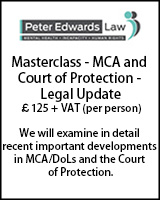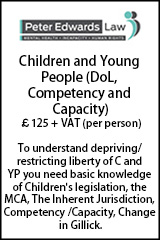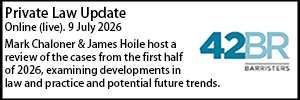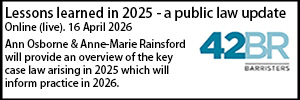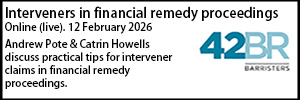Care proceedings, histopathological examination, and concurrent police investigations
- Details
Emily Verity analyses an important Family Division case regarding expert evidence in cases involving the death of a child and where there is a parallel police investigation.
The case of London Borough of Hammersmith and Fulham v G & Ors [2024] EWHC 2200 (Fam), decided by Mr Justice Keehan in the High Court of the Family Division, was a fact-finding hearing in care proceedings relating to the siblings of a young child who tragically died in the family home. The care proceedings ran alongside a criminal investigation into the child’s death. Histopathological examination of the child’s rib cage as part of the post-mortem process revealed fractures including what were said to be micro-fractures that had been caused non-accidentally.
During the course of the proceedings, Keehan J granted permission for the parents to instruct a second histopathologist. Unusually, this expert was based in the USA in light of the shortage of experts in this jurisdiction in this highly specialised field.
In his judgment, Keehan J made a number of important observations as to the process of identifying and aging fractures on a histopathological basis. He rejected the evidence from a leading expert in this field, preferring that of the second expert instructed within the proceedings. The judgment also contains guidance as to good practice when experts are instructed by the police as part of a criminal investigation but also as part 25 experts in family proceedings. The children were reunited with their parents by agreement at the conclusion of the hearing.
Facts
The case involved three children, A, 11 years old, B aged 5 and C who is 11 months old. F was the Father of C. The mother and father had another child D. She tragically died in June 2022. Following her death, A and B were cared for by a family member. C was born during proceedings. The local authority issued care proceedings and applied for his removal with a care plan of foster care. This was refused and his placement approved with his parents in a residential assessment unit. From the conclusion of placement, C lived his parents under 24 hour supervision by professional support workers.
Ultimately it was accepted that D’s death resulted from a tragic accident when she slipped from the bottom of a three bed bunk and became entangled around her neck by a decorative scarf tied in the lower bars of the bunk bed. However on post mortem examination a number of anterior and posterior rib fractures were identified. Histopathological examination of D’s rib cage identified other appearances of her ribs which were said to be fractures which predated her death by 3 to 7 days.
The purpose of the fact finding was to determine:
- Whether D sustained any rib fractures, and if so,
- When they were sustained,
- Whether they were inflicted on accidental injuries, and
- If the former, who inflicted them.
Two small fractures of the sternum were of no material significant in light of the conclusions.
A subsidiary issue related to A and whether he was the subject of physical harm caused to him by his mother in 2019 and his mother and/or the father in August 2020.
The mother and the father denied causing any injuries to D and asserted that that any rib fractures she was found to have sustained occurred either a) when she fell or slipped from the bed and became entangled in the scarf, b) in the frantic attempts to extricate her from the scarf and/or the rungs of the bunk bed ladder in which she was intertwined and/or c) during CPR performed first by the father and then by a succession of police officers and/or paramedics.
Although the parents had vulnerabilities due to their earlier life experiences, there was no evidence, other than the disputed forensic medical evidence to suggest that D had been ill treated or subjected to any abusive handling by either parent.
Law
The relevant law will be familiar: the burden of proof was on the local authority, and the standard the simple balance of probabilities. Keehan J referred in particular to the following passage:
In Re H; Re B (A Child) [2004] EWCA 567 at paragraph 23 Dame Butler-Sloss observed that:
“in the brief summary of the submissions set out above there is a broad measure of agreement as to some of the considerations emphasized by the judgment in R v Cannings that are of direct application in care proceedings. We adopt the following:-
i) The cause of an injury or an episode that cannot be explained scientifically remains equivocal.
ii) Recurrence is not in itself probative.
iii) Particular caution is necessary in any case where the medical experts disagree, one opinion declining to exclude a reasonable possibility of natural cause.
iv) The court must always be on guard against the over-dogmatic expert, the expert whose reputation or amour propre is at stake, or the expert who has developed a scientific prejudice.
v) The judge in care proceedings must never forget that today’s medical certainty may be discarded by the next generation of experts or that scientific research will throw light into corners that are at present dark.”
Expert evidence
Dr Fitzpatrick-Swallow, consultant pathologist, and Dr Marnerides, consultant perinatal and paediatric pathologist, conducted the post mortem of D on 29 June 2022. They identified, macroscopically (with the naked eye), a fracture on her left 6th posterior rib with corresponding soft tissue injuries found externally around the site of this fracture. Radiological examination (x ray) of D’s rib cage did not identify any fractures. The rib cage was sent for histopathological examination by Professor Mangham: examination under the microscope of slides containing slices of the rib cage.
The post mortem report post dated the bone pathology report of Professor Mangham.
Dr Ward, consultant paediatrician reported on:
- Causation of rib fractures sustained by D
- Causation of injuries sustained by A, namely four areas of bruising in August 2020.
Unusually, permission was granted for Professor McCarthy, Professor Emeritus of Pathology and Orthopaedic Surgery at the John Hopkins School of Medicine, Baltimore, USA, and a consultant bone pathologist to be instructed in these proceedings in respect of the histopathological examination of D’s rib cage.
At the fact finding hearing, Dr Fitzpatrick-Swallow, Dr Ward, Professor Mangham and Professor McCarthy gave evidence. the issues were the ages and causation of any rib fractures, and whether their was pre-disposal to suffering fractures.
Professor Mangham and Professor McCarthy came to markedly different conclusions having examined the histopathological slides produced from D’s ribcage.
Professor Mangham identified:
- 9 acute partial rib fractures – a typical in distribution for fractures caused by CPR, namely asymmetry (nearly all on left side), presence in ribs not typically fractured by CPR (namely left anterior first rib and left anterior 10th and 12th ribs) and posterior rib fracture (2nd rib) asserting that posterior rib fractures are not caused by CPR (in addition the left 6th posterior rib was fractured but this was not apparent to Professor Mangham at the time of his report);
- 15 older partial rib fractures which occurred between 3 to 7 days prior to death
- 2 small sternal fractures
He concluded that all, or at least some of the acute fractures and all of the older rib fractures were caused non-accidentally as a result of forceful chest compression, and therefore at least some, if not all, of the acute rib fractures were caused by non-accidental injury.
The Court noted that Professor Mangham did not identify the left 6th posterior rib fracture identified at post mortem examination until after he had received and read Professor McCarthy’s report.
Professor McCarthy identified:
- 12 acute fractures which occurred around the time of death;
- These fractures were seen in the left and right sides of the rib cage: 8 anterior, 4 posterior;
- The 6th posterior fracture, not identified by Professor Mangham until that point was identified and included in the 12,
- The rib features described by Professor Mangham as fractures, were not fractures but features of growth and remodelling seen in babies and infants.
He concluded that all of the fractures were likely to have been sustained, or could have been sustained in the course of CPR; slipping/falling from the bed or frantically seeking to remove the scarf from her neck, or seeking to extricate D from the bunk bed ladder.
It was agreed that D had been subjected to prolonged, sustained resuscitation attempts via CPR for at least 90 minutes.
Professor McCarthy was permitted to hear the evidence of Professor Mangham via video link from the USA. Professor McCarthy was permitted to listen to the evidence of Professor McCarthy.
Professor Mangham readily acknowledged that he had missed the left 6th posterior rib fracture, identified by Dr Fitzpatrick-Swallow and Dr Marnerides in post mortem and by Professor McCarthy via examination of the histopathological slides, which had caused significant trouble during the proceedings. He had subsequently checked the slide and could see it ‘as clear as day’, but could not explain the mistake.
There had been a meeting after the initial post mortem report between Professor Mangham and Dr Fitzpatrick-Swallow to seek to explain the discrepancy. Serious consideration was given as to whether the wrong rib cage had been provided to Professor Mangham, and whether DNA analysis could identify whether the rib cage in fact as that of D. DNA testing could not provide a match. Extensive enquiries, taking months, were undertaken into procedures and processes for the receipt, identification and examination of this rib cage established that it was D’s rib cage.
Professor Mangham could not explain how he had re-examined the slides and still not found the fracture. He attempted to explain he had re-examined the wrong slide – namely slide 37 rather than 49 but slide 37 showed a different fracture which both experts had identified. When pressed his answer was that this was not the only case he had to deal with. The Court noted the considerable work burden, although this obviously was not any sort of explanation.
In concluding that the 9 acute rib fractures he had identified could not result from prolonged CPR, he relied on asymmetry, position (11/12th being free floating ribs) and number – and identified 24 fractures. He was challenged in cross examination that by using that number he was including all the other fractures which he had concluded were not caused close to time of death. He accepted mistakenly including those fractures, but could not explain his mistake save that he was tired, at which point the case was adjourned.
On resuming his evidence, Professor Mangham acknowledged some of the acute rib fractures could have been caused during CPR. He had not included this explanation in his written report, he said because he was focussing on whether all identified rib fractures had been caused by CPR. The Court expressed consternation at why this expert had this focus.
Professor Mangham did not accept Professor McCarthy’s evidence that many of the alleged fractures were normal features of bone growth, commonly seen in babies and young children. He maintained that signs of fracture included the following features:
- Osteocartilaginous spurs;
- Fibrinoid material;
- Mesenchymal tissue/response;
- Granulation tissue with osteoclast front/deposition/cell resorption;
- Necrotic chondrocytes/zonal osteocyte necrosis.
Getting into the technical detail a little more: all the older fractures/features identified were seen either at the costochondral junction or the osteocartilaginous junction (ie posterior rib head).
Professor Mangham was asked about the presence of haemorrhage identified around fractures identified by Professor McCarthy. He replied it was likely he too had seen evidence of haemorrhage but had not mentioned it, was focussed on signs of chronicity (age) and does not mention every feature observed.
The Court commented that it may be good practice to look for the oldest signs of a suspected fracture, and may not mention every feature observed on a slide. But as haemorrhage is a sign of an acute fracture rather than chronic, this omission in describing chronic fractures could not be accepted. The presence of haemorrhage is highly material, and may assist on whether there is a fracture at all, and was not identified in Mangham’s ‘old fractures’.
Finally, at the end of his evidence, Professor Mangham referred to osteocyte necrosis, a feature which led him to conclude the fractures were chronic rather than acute. He said identification of this was subjective, when it occurs it is controversial, and it needed careful evaluation. Prolonged CPR, he said, would negate reliance on this feature to time the fracture. The Court noted that this important feature of Professor Mangham’s evidence did not appear in any of his reports.
The Court noted the significant delays in Professor Mangham’s responses to directions from the Court, from pressure of work.
In contrast, Professor McCarthy agreed with Dr Fitzpatrick-Swallow’s opinion that the left 6th posterior fracture could have resulted from blunt force injury when D slipped/fell out of her bunk onto the metal ladder/bed. He had heard the 999 call recording and viewed the body worn footage of resuscitation attempts in the family home. He praised the emergency operator’s response and noted the evident terrified panic of the father. He accepted that father could have caused the rib fractures whilst administering CPR.
In relation to the disputed fractures, he had not identified any haemorrhage, which excluded these as fractures. The remaining 12 fractures he accepted were acute and could have been caused by CPR/D falling through the ladder or being extricated from the scarf. He acknowledged he did not know a previous case where so many fractures were sustained through CPR.
The position of the left 6th rib fracture, closer to the mid point than to the transverse process and away from the other fractures, supported his view, in conflict with Professor Mangham, that this fracture was caused by blunt impact trauma.
Professor McCarthy expressed reservations about reliance on research papers dealing with the incidence of rib fractures sustained during CPR because most were written by radiologists relying on x rays to identify fractures, which is not an accurate method to identify rib fractures (as in this case none were identified through that process) and therefore these studies underreported the incidence of rib fractures sustained in CPR.
Professor McCarthy enjoyed the particular advantage of drawing on substantial experience as an orthopaedic surgeon to comment on growth and remodelling processes in babies and infants.
Professor Mangham was given an opportunity to give further evidence having heard Professor McCarthy’s and in essence declined.
During the course of the police investigation, a number of meetings (eg June, October 2023 and February 2024) were held between experts instructed by the police and on occasion the police attended the meetings. The Court diplomatically described the manner of minuting these meetings as ‘inconsistent’.
Analysis
The Court placed particular reliance on the statements of the parents, the audio recording of the 999 call, video evidence of attempts to resuscitate D at home, and the reports of Dr Fitzpatrick-Swallow and Dr Ward.
Professor Mangham is a highly respected and hugely experienced histopathologist. He is the only forensic consultant histopathologist accepting instruction in cases of suspicious death and/or alleged inflicted injuries in the country. This no doubt explains his huge workload. Reluctantly the Court found itself unable to accept his opinions or conclusions, referring to submissions on behalf of the father:
- His evidence was linear and quick to offer a non-accidental causation of the acute rib fractures of D having simply ruled out CPR as a cause without considering alternative mechanisms. By referring to 24 fractures in ruling out CPR to explain some fractures, he was including fractures where CPR was not a potential explanation – this was a grave error which spoke of a closed mind to an accidental cause of injury;
- He strayed beyond his area of expertise;
- He would not consider the anterior rib fractures separately to the other fractures in the case;
- Regarding the left 6th posterior rib fracture, he persisted in his view that it could not have been caused by blunt force to the chest wall, without appreciating the cause could be a blow lateral to the fracture site, causing that green stick fracture, as agreed by Dr Fitzpatrick-Swallow and Professor McCarthy;
- He did not set out controversial areas or features pointing to a different conclusion, for example presence of haemorrhage in the ‘older’ fractures; signs of chronicity without including factors which potentially contradicted chronicity; the controversial nature of osteocyte necrosis requiring careful evaluation – and oral evidence that prolonged CPR negated reliance on osteocyte necrosis;
- Repeated mistakes in identification of the 6th left posterior rib, even following review when other professionals point out the discrepancy, indicating a fixed view with high risk consequences;
- Defective use of medical literature;
- Failure to comply with directions regarding the internal review and regarding Part 25 instructions illustrated early view as to causation which he was not prepared to reconsider;
- Failure to read the final addendum report of Dr Fitzpatrick-Swallow and listen to the 999 call and video resuscitation attempts until very shortly before his evidence.
The Court found Professor McCarthy’s conclusions and reasons compelling. The Court concluded that it could not make findings of fact based solely on Professor Mangham nor where they differ from Professor McCarthy. The Court expressed great regret, and a very real sense of an expert who was overburdened with work, who had thus made errors in his examination of the forensic material and who had closed his mind to possible or probable accidental causes for the injuries identified. In any event, in this case, Professor Mangham had fallen below his own high standards as a forensic expert witness.
Therefore the Court found that the rib fractures had been sustained accidentally and the lesions were features of bone remodelling and not fractures.
Delay
The Court commented on the considerable delays: three fixtures were adjourned because police expert evidence was not available or complete or relevant material had not been disclosed between the parties, police and CPS. As a result, the parents had to endure the second anniversary of D’s death taking place during the listed fact finding. The tension between concurrent preparation for a Family Court fact finding and police investigation can be particularly acute where a) one or more experts instructed by the police are also Part 25 experts in the care proceedings, or called to give evidence at the fact finding or b) where an expert in care proceedings requires access to forensic material held by the police which has been examined or tested by experts instructed by the police.
Keehan J gave the following important guidance: It is essential for the fair and effective operation of the family justice system and of the criminal justice system that there is open, regular and effective dialogue and co-operation between the parties to the care proceedings, most obviously with the local authority, and the police and/or the CPS. Plainly there will be exceptions where a particular course of action might imperil the integrity of the family or of the criminal proceedings. In which case it is likely that orders will have been made by the court to require a party not to disclose information or documents to the police or the CPS or to permit the police to withhold evidence from a party or all parties to the care proceedings as a result of the making of a Public Interest Immunity order. The recently launched The Disclosure of Information between Family and Criminal Agencies and Jurisdictions: 2024 Protocol is an essential starting point.
The Court went on to highlight that in many cases where there are concurrent family proceedings and criminal investigations into the death of or alleged serious injuries caused to a child, the medical experts instructed by the police will be, or are very likely to become experts instructed in the family proceedings or will be called to give evidence at a fact finding hearing. There are differences in the duties and responsibilities of a medical expert when they are instructed by the police in a criminal investigation and when they are instructed to prepare a report in family proceedings. Nevertheless, if and when the police and/or the CPS decide to convene a meeting with one or more of their instructed medical experts it would be advisable, as a matter of good practice, for a minute or note of the meeting to be taken so that it may be disclosed in due course to the parties in the family proceedings. Moreover, and where practicable, it would be advisable for the parties to the family proceedings to be given advance notice of the proposal to convene such a meeting.
Conclusion
The decision by the LA not to pursue the findings of fact at the conclusion of the expert evidence was endorsed by the Court. The Court concluded that the only plausible or likely explanations for the cause of her acute rib fractures, all of which were sustained around the time of death, were:
- When D fell through the bunk bed ladder causing blunt force trauma (left posterior 6thrib); and/or
- When her parents made frantic efforts to remove the scarf from around her neck; and/or
- When they tried to extricate her from the bunk bed and the bunk bed ladder; and/or
- The administration of CPR over a sustained and prolonged period of time.
By agreement the children returned to the care of their parents at the conclusion of the hearing. The parents reasonably declined the offer of support via a s. 16 CA 1989 Family Assistance Order. The Judge gave credit to the parents whom had endured caring for their newborn under the unhappy and stressful disruption of very close and constant supervision with considerable fortitude and dignity.
Professor McCarthy and Professor Mangham were provided a copy of the draft judgment. Prof McCarthy made no further comment. Professor Mangham provided a letter and annotations to judgment some of which were accepted, most of which were not. Given that Professor Mangham is the only forensic consultant histopathologist accepting instruction in cases of suspicious death and/or alleged inflicted injuries in the country, the Court was persuaded that the publication of the judgment, including the reasons for preferring the second instructed expert, was in the public interest and the interests of justice.
Emily Verity is a barrister at 1 GC Family Law. She was Junior Counsel for the Second Respondent Father, led by Louise MacLynn KC, and instructed by Denise Herman and Hannah Field of Blaser Mills.
Sam Momtaz KC, Laura Briggs KC, Louise MacLynn KC and Mark Rawcliffe – all of 1GC – also appeared in this case.
























